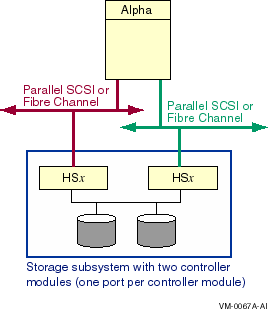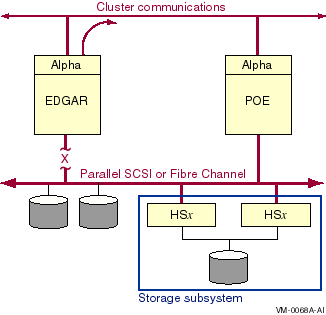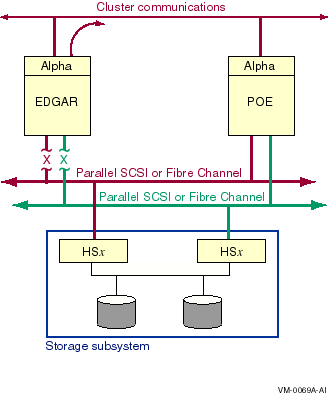![[OpenVMS documentation]](../../images/openvms_doc_banner_top.gif)
|
![[Site home]](../../images/buttons/bn_site_home_off.gif)
![[Send comments]](../../images/buttons/bn_comments_off.gif)
![[Help with this site]](../../images/buttons/bn_site_help_off.gif)
![[How to order documentation]](../../images/buttons/bn_order_docs_off.gif)
![[OpenVMS site]](../../images/buttons/bn_openvms_off.gif)
![[Compaq site]](../../images/buttons/bn_compaq_off.gif)
|
| Updated: 11 December 1998 |
![[OpenVMS documentation]](../../images/openvms_doc_banner_top.gif)
|
![[Site home]](../../images/buttons/bn_site_home_off.gif)
![[Send comments]](../../images/buttons/bn_comments_off.gif)
![[Help with this site]](../../images/buttons/bn_site_help_off.gif)
![[How to order documentation]](../../images/buttons/bn_order_docs_off.gif)
![[OpenVMS site]](../../images/buttons/bn_openvms_off.gif)
![[Compaq site]](../../images/buttons/bn_compaq_off.gif)
|
| Updated: 11 December 1998 |
Guidelines for OpenVMS Cluster Configurations
| Previous | Contents | Index |
For storage subsystems, availability is determined by the availability
of the storage device as well as the availability of the path to the
device.
5.4.1 Availability Requirements
Some costs are associated with optimizing your storage subsystems for higher availability. Part of analyzing availability costs is weighing the cost of protecting data against the cost of unavailable data during failures. Depending on the nature of your business, the impact of storage subsystem failures may be low, moderate, or high.
Device and data availability options reduce and sometimes negate the
impact of storage subsystem failures.
5.4.2 Device and Data Availability Optimizers
Depending on your availability requirements, choose among the availability optimizers described in Table 5-4 for applications and data with the greatest need.
| Availability Optimizer | Description |
|---|---|
| Redundant access paths | Protect against hardware failures along the path to the device by configuring redundant access paths to the data. |
| Volume Shadowing for OpenVMS software |
Replicates data written to a virtual disk by writing the data to one or
more physically identical disks that form a shadow set. With replicated
data, users can access data even when one disk becomes unavailable. If
one shadow set member fails, the shadowing software removes the drive
from the shadow set, and processing continues with the remaining
drives. Shadowing is transparent to applications and allows data
storage and delivery during media, disk, controller, and interconnect
failure.
A shadow set can contain up to three members, and shadow set members can be anywhere within the storage subsystem of an OpenVMS Cluster system. Reference: See Volume Shadowing for OpenVMS for more information about volume shadowing. |
| System disk redundancy |
Place system files judiciously on disk drives with multiple access
paths. OpenVMS Cluster availability increases when you form a shadow
set that includes the system disk. You can also configure an OpenVMS
Cluster system with multiple system disks.
Reference: For more information, see Section 11.2. |
| Database redundancy | Keep redundant copies of certain files or partitions of databases that are, for example, updated overnight by batch jobs. Rather than using shadow sets, which maintain a complete copy of the entire disk, it might be sufficient to maintain a backup copy on another disk or even on a standby tape of selected files or databases. |
| DECevent |
DECevent, in conjunction with volume shadowing, can detect most
imminent device failures with sufficient lead time to move the data to
a spare device.
Enhance device reliability with appropriate software tools. Use device-failure prediction tools, such as DECevent, where high availability is needed. When a shadow set member has an increasing fault rate that might indicate potential failure, DECevent works with Volume Shadowing for OpenVMS to make a shadow set copy of the suspect device to a spare device. After the copy is made, the suspect device can be taken off the system for examination and repair without loss of data availability. |
| Newer devices | Protect against failure by choosing newer devices. Typically, newer devices provide improved reliability and mean time between failures (MTBF). Newer controllers also improve reliability by employing updated chip technologies. |
| Implement thorough backup strategies | Frequent and regular backups are the most effective way to ensure the availability of your data. |
The CI interconnect provides the highest OpenVMS Cluster availability
with redundant, independent transmit-and-receive CI cable pairs. The CI
offers multiple access paths to disks and tapes by means of dual-ported
devices between HSC or HSJ controllers.
5.5.1 Supported Controllers and Devices
The following controllers and devices are supported by the CI interconnect:
DSSI-based configurations provide shared direct access to storage for systems with moderate storage capacity. The DSSI interconnect provides the lowest-cost shared access to storage in an OpenVMS Cluster.
The storage tables in this section may contain incomplete lists of
products.
5.6.1 Supported Devices
DSSI configurations support the following devices:
Reference: RZ, TZ, and EZ SCSI storage devices are
described in Section 5.7.
5.7 SCSI-Based Storage
The Small Computer Systems Interface (SCSI) bus is a storage
interconnect based on an ANSI industry standard. You can connect up to
a total of 8 or 16 nodes (3 of which can be CPUs) to the SCSI bus.
5.7.1 Supported Devices
The following devices can connect to a single host or multihost SCSI bus:
The following devices can connect only to a single host SCSI bus:
The Fibre Channel interconnect is a storage interconnect that is based
on an ANSI industry standard.
5.8.1 Storage Devices
The HSG storage controllers can connect to a single host or to a
multihost Fibre Channel interconnect.
5.9 Host-Based Storage
Host-based storage devices can be connected locally to OpenVMS Cluster member systems using local adapters. You can make this locally connected storage available to other OpenVMS Cluster members by configuring a node as an MSCP server.
You can use local adapters to connect each disk to two access paths
(dual ports). Dual porting allows automatic failover of disks between
nodes.
5.9.1 Internal Buses
Locally connected storage devices attach to a system's internal bus.
Alpha systems use the following internal buses:
VAX systems use the following internal buses:
Following is a list of local adapters and their bus types:
This chapter describes multipath SCSI support for parallel SCSI and Fibre Channel configurations. Multipath support is available on OpenVMS Alpha Version 7.2.
At the time that OpenVMS Version 7.2 is released, the following restrictions apply:
These restrictions will be removed by an update kit, shortly after the release of OpenVMS Version 7.2. The information in this chapter pertaining to these features is provided in advance as an aid for future planning. |
The following topics are presented in this chapter:
6.1 Overview of Multipath SCSI Support
A multipath SCSI configuration provides failover from one path to a
device to another path to the same device. Multiple paths to the same
device increase the availability of that device for I/O operations.
Multiple paths also offer higher aggregate performance. Figure 6-1
shows a multipath SCSI configuration. Two paths are configured from a
computer to the same virtual storage device.
Multipath SCSI configurations can use either parallel SCSI or Fibre Channel as the storage interconnect, as illustrated by Figure 6-1.
Two or more paths to a single device are called a multipath set. When the system configures a path to a device, it checks for an existing device with the same name but a different path. If such a device is found, and multipath support is enabled, the system either forms a multipath set or adds the new path to an existing set. If multipath support is not enabled, then no more than one path to a device is configured.
The system presents a multipath set as a single device. The system selects one path to the device as the "current" path, and performs all I/O over this path until there is a failure or the system manager requests that the system switch to another path.
Multipath SCSI support provides two types of failover:
Direct SCSI to direct SCSI failover requires the use of multiported
SCSI devices. Direct SCSI to MSCP served failover requires multiple
hosts per SCSI bus, but does not require multiported SCSI devices.
These two failover types can be combined. Each type and the combination
of the two are described next.
6.1.1 Direct SCSI to Direct SCSI Failover
Direct SCSI to direct SCSI failover can be used on systems with multiported SCSI devices. The dual HSZ70, the HSZ80 and the HSG80 are examples of multiported SCSI devices. A multiported SCSI device can be configured with multiple ports on the same physical interconnect so that if one of the ports fails, the host can continue to access the device through another port. This is known as transparent failover mode and has been supported by OpenVMS since Version 6.2.
OpenVMS Version 7.2 introduces support for a new failover mode in which the multiported device can be configured with its ports on different physical interconnects. This is known as multibus failover mode.
The HSx failover modes are selected by HSx console commands. Transparent and multibus modes are described in more detail in Section 6.2.
A generic illustration of a multibus failover configuration is shown in Figure 6-1.
The two logical disk devices shown in Figure 6-1 represent virtual storage units that are presented to the host by the HSx controller modules. Each logical storage unit is "online" to one of the two HSx controller modules at a time. When there are multiple logical units, they can be online to different HSx controllers so that both HSx controllers can be active at the same time.
In transparent mode, a logical unit switches from one controller to the other when an HSx controller detects that the other controller is no longer functioning.
In multibus mode, a logical unit connection is switched from one controller to the other when one of the following events occurs:
Figure 6-1 Multibus Failover Configuration

Note the following about this configuration:
The multibus configuration offers the following advantages over transparent failover:
6.1.2 Direct SCSI to MSCP Served Failover
The feature described in this section is not supported at the time OpenVMS Version 7.2 is released. This restriction will be removed by an update kit, shortly after the release of OpenVMS Version 7.2. |
OpenVMS provides support for multiple hosts that share a SCSI bus. This is known as a multihost SCSI OpenVMS Cluster system. In this configuration, the SCSI bus is a shared storage interconnect. Cluster communication occurs over a second interconnect (LAN, DSSI, CI, or MEMORY CHANNEL).
Multipath support in a multihost SCSI OpenVMS Cluster system enables failover from directly attached SCSI storage to MSCP served SCSI storage, as shown in Figure 6-2.
Figure 6-2 Direct SCSI to MSCP Served Configuration With One Interconnect

Note the following about this configuration:
6.1.3 Configurations Combining Both Types of Multipath Failover
In a multihost SCSI OpenVMS cluster system, you can increase storage
availability by configuring the cluster for both types of multipath
failover (direct SCSI to direct SCSI and direct SCSI to MSCP served
SCSI), as shown in Figure 6-3.
Figure 6-3 Direct SCSI to MSCP Served Configuration With Two Interconnects

Note the following about this configuration:
This configuration provides the advantages of both direct SCSI failover and direct to MSCP served failover.
6.2 HSx Failover Modes
The HSZ70, HSZ80, and the HSG80 implement two modes of failover
operation when they are in a dual-redundant configuration, transparent
failover mode and multibus failover mode. For the system to operate
correctly, the HSx failover mode must be compatible with the
configuration of the interconnect hardware and the host operating
system software.
6.2.1 Transparent Failover Mode
In transparent failover mode, the HSx presents each logical unit on one port of the dual controller pair. Different logical units may be assigned to different ports, but an individual logical unit is accessible through one port at a time. When the HSx detects that a controller module has failed, it moves the logical unit to the corresponding port on the surviving controller.
The assumption in transparent mode is that the two ports are on the same host bus, so the logical unit can move from one port to the other without requiring any changes to the host's view of the device. The system manager must ensure that the bus configuration is correct for this mode of failover. Transparent failover has been supported by OpenVMS since V6.2.
To select transparent failover mode, enter the following command at the HSx console:
SET FAILOVER COPY=this_controller or other_controller |
An example of the output of a console SHOW command on an HSx in transparent mode follows:
z70_A => sho this
Controller:
HSZ70 ZG64100160 Firmware XB32-0, Hardware CX25
Configured for dual-redundancy with ZG64100136
In dual-redundant configuration
Device Port SCSI address 7
Time: 02-DEC-1998 09:22:09
Host port:
SCSI target(s) (0, 2, 3, 4, 5, 6)
Preferred target(s) (3, 5)
TRANSFER_RATE_REQUESTED = 20MHZ
Host Functionality Mode = A
Allocation class 0
Command Console LUN is target 0, lun 1
Cache:
32 megabyte write cache, version 4
Cache is GOOD
Battery is GOOD
No unflushed data in cache
CACHE_FLUSH_TIMER = DEFAULT (10 seconds)
NOCACHE_UPS
|
In multibus failover mode, the HSx makes each logical unit visible to the host on all ports of the dual controller pair. This allows the host to be aware of all the possible paths to the device. There are two advantages to having the host aware of all the paths to a device:
Note that although the logical unit is visible on all ports, it is online, and thus capable of doing I/O, on the ports of only one controller at a time. Different logical units may be online to different controllers, but an individual logical unit is online to one controller at a time.
You can determine which controller a logical unit is online to by entering the HSx console command, as follows:
z70_A => sho unit full
LUN Uses
--------------------------------------------------------------
D200 DISK20300
Switches:
RUN NOWRITE_PROTECT READ_CACHE
MAXIMUM_CACHED_TRANSFER_SIZE = 32
ACCESS_ID = ALL
State:
ONLINE to the other controller
PREFERRED_PATH = OTHER_CONTROLLER
Size: 2050860 blocks
|
The host executes I/O to a logical unit on one path at a time, until that path fails. If a controller has two ports, as the HSZ80 and the HSG80 controllers do, then different hosts can access the same logical unit over different ports of the controller to which the logical unit is online.
An HSx in multibus failover mode can only be used with the multipath functionality introduced in OpenVMS Version 7.2.
To select multibus failover mode, enter the following command at the HSx: console:
SET MULTIBUS_FAILOVER COPY=this_controller or other_controller |
An example of the output of a console SHOW command on an HSx controller in multibus mode follows:
z70_B => sho this
Controller:
HSZ70 ZG64100136 Firmware XB32-0, Hardware CX25
Configured for MULTIBUS_FAILOVER with ZG64100160
In dual-redundant configuration
Device Port SCSI address 6
Time: NOT SET
Host port:
SCSI target(s) (0, 2, 3, 4, 5, 6)
TRANSFER_RATE_REQUESTED = 20MHZ
Host Functionality Mode = A
Allocation class 0
Command Console LUN is target 0, lun 1
Cache:
32 megabyte write cache, version 4
Cache is GOOD
Battery is GOOD
No unflushed data in cache
CACHE_FLUSH_TIMER = DEFAULT (10 seconds)
NOCACHE_UPS
|
| Previous | Next | Contents | Index |
![[Site home]](../../images/buttons/bn_site_home_off.gif)
![[Send comments]](../../images/buttons/bn_comments_off.gif)
![[Help with this site]](../../images/buttons/bn_site_help_off.gif)
![[How to order documentation]](../../images/buttons/bn_order_docs_off.gif)
![[OpenVMS site]](../../images/buttons/bn_openvms_off.gif)
![[Compaq site]](../../images/buttons/bn_compaq_off.gif)
|
![[OpenVMS documentation]](../../images/openvms_doc_banner_bottom.gif) |
|
Copyright © Compaq Computer Corporation 1998. All rights reserved. Legal |
6318PRO_005.HTML
|